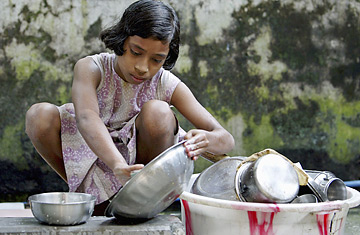
An 11-year-old child laborer washes dishes at a house in Siliguri, India.
Dinnertime finds the famous Haldiram's restaurant in south Delhi noisy and crowded. The larger tables are taken up by affluent extended families, the very picture of upwardly mobile urban India — well-dressed grandparents, several stylish young couples, and a multitude of happy and excited children. On smaller tables nearby are the ayahs (child-minders), looking heartbreakingly out of place, not eating and waiting to be called on to deal with the kids when they get out of hand. More often than not, the ayahs are themselves children, barely in their pre-teens. Each makes less money each month than the family whose children she cares for will spend on dinner that night. She will never go to school, never acquire any skills that could get her any other form of employment when she's older, and will spend her life eating leftovers and wearing hand-me-downs.
Employment of children in such occupations is not only heartbreaking; it is also illegal. Last October, the government extended the prohibition on children under 14 working in "hazardous" professions to include the domestic and hospitality sectors. This followed a sustained campaign by rights groups in the wake of a series of reports on children abused in these sectors. Despite the legal change, the government-affiliated V.V. Giri Labour Institute in Noida estimates there are 12.5 million children younger than 14 working in India. (UNICEF puts the real figure at somewhere between 75 and 90 million.) The 6,669 violations and 872 prosecutions for employing children in the domestic and hospitality sectors reported by the Labor Ministry over the past year, then, are a drop in the ocean.
When the government first moved to ban child labor in these two sectors, employers and some children's rights activists pointed out that millions of children worked in order to survive. If forced out of employment, who would feed them? Where were the schools and shelters to absorb them and offer them a brighter future? Some even conceded that at least some employers treated their child-workers better than their own indigent parents could. "Given that it is a multi-dimensional problem, the ban has been a tiny but positive step forward," says Farida Lambay, founder-trustee of child rights NGO Pratham, and vice-principal of College of Social Work. "It has been successful at least in the big cities." Lambay cites a UNICEF initiative to get the hotel owners' association to agree to refrain from hiring children, and her own organization's campaign to get 4,000 housing societies to certify that no children were working in homes, as examples of success of the ban. "Overall, 19,000 children were rescued during the last year in Mumbai," she says, adding, "It is a great beginning."
Other activists are less optimistic. "The entire thing has been a disaster," says Umesh Kumar Gupta from Bachpan Bachao Andolan, an NGO which has been at the forefront of the anti-child-labor movement. He cites the example of the central Indian state of Madhya Pradesh, one of the largest in terms of size. "The state government claims it found only 94 child laborers across the length and breadth of the state. When they are in such a state of denial, how will they ever remedy the problem?" He adds that the few children rescued would soon be employed again, because the poverty at the root of the problem has not been addressed. And the rescue homes at which others find themselves are often overcrowded and offer little by way of educational and vocational training opportunities.
Ingrid Srinath, CEO of Child Rights and You, says, "The police, after rescuing the children, often don't know where they come from. Sometimes their families don't want them back, and actually want the children to continue working because they need the income. The only solution for such children is either repatriation or putting them in a juvenile home, where they are treated like criminals and learn no skills except basket weaving!" She insists the ban was only a face-saving exercise by the government. "It was an attempt to avoid having to completely ban child labor, which will be difficult to implement," she says. "Implementing this limited ban is difficult enough."
The most optimistic prognoses of India's economic growth story often rely on its huge "demographic dividend" — 35% of its 1.1 billion people are younger than 15. However, with millions of children not going to school and picking up no marketable skills, this huge reservoir of young people could well be a ticking time bomb of social unrest. Harjot Kaur, director at the Ministry of Labor and Employment, insists the government is acting to improve the situation, noting that it plans a survey to establish the number of working children in India, and plans to extend the National Child Labor Project (aimed at eliminating the practice) from 200 to 600 districts. Still, while activists concede that the challenge is daunting, they question whether the government is addressing it with sufficient vigor. The private sector, meanwhile, has begun to grasp the significance of educating India's impoverished youth. India 's IT giant Infosys, for example, has already set up 10,000 libraries in rural areas across the country, while Wipro is adopting 7,500 schools in the southern state of Karnataka.
Activists are hoping that the combination of political action and far-sighted business investment can help ensure that a booming India has better prospects to offer the adolescent ayahs in Haldiram's than the scraps they'll dine on tonight.
